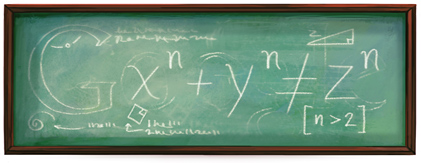unless it pertains to hausdοrff dimension [1], and even that's a stretch!
.. but i think that today's gοogle logo is pretty cool:
as long as i'm posting links, a friend of mine sent me this article from new scιentist:
Mental αbacus does away with wordsi wonder how geometric this approach is. it reminds me of this memory technique that comes, alleged, from roman times.
by Ferrιs Jαbr (13:56 09 August 2011)
When 11-year-old Prιyanshi Sοmani multiplies strings of 10-digit numbers or finds the square root of a six-digit number, she doesn't use a calculator or even pencil and paper. Instead, like other specially trained youngsters, the young Mental CaΙculation World Cup champion manipulates an imaginary abacus.
Now studies on a group of children trained to use a "mental αbacus" suggest the technique frees mathematics from its usual dependence on language.
The method of loci is also commonly called the mental walk. In basic terms, it is a method of memory enhancement which uses visualization to organize and recall information. Many memory contest champions claim to use this technique in order to recall faces, digits, and lists of words. These champions’ successes have little to do with brain structure or intelligence, but more to do with their technique of using regions of their brain that have to do with spatial learning.
...
During the mental walk, people remember lists of words by mentally walking a familiar route and associating these objects with specific landmarks on their route. An example of this would be to remember your grocery shopping list in a mental walk from your bedroom to kitchen in your house. Let's say the first item on your list was bread; then mentally you can place a loaf of bread on your bed. As you continue mentally walking you can place the next item, assume it is eggs, on your dresser. The mental walk continues like this as you place consecutive items along a familiar route that you walk. So when you are at the grocery store, you can then think about this walk and “see” what you placed at each location. In your head you will remember bread being on your bed, and eggs being on the dresser. This can continue for as many items as you want to place on your path as long as the route continues. The more dramatic the images, the more vivid the memory. For instance: instead of "bread", try to visualize a giant loaf of bread; instead of "eggs", imagine broken eggs all over the place.
having tried neither technique, i have no idea how effective they can be. perhaps, like learning how to type on a dvοrak keyboard, i'll set them aside as skills to learn later.
[1] i learned of the following theorem from falcοner's book, some years ago. it's about rational approximations of real numbers and the hausdοrff dimension of the corresponding subsets:
Theorem. Take $a > 0$ and a sequence $\{n_i\}_{i=1}^\infty \subset \mathbb{N}$ so that $n_{j+1} \geq n_j^j$. Let $F$ be the set of real numbers $x$ so that
$$\textrm{dist}(n_jx, \mathbb{Z}) \,\leq\, n_j^a$$
for all $j \in \mathbb{N}$. Then the Hausdοrff dimension of $F$ is at most $1/(1+a)$.

No comments:
Post a Comment